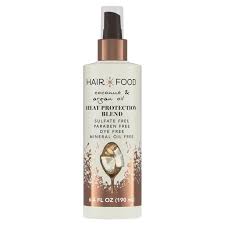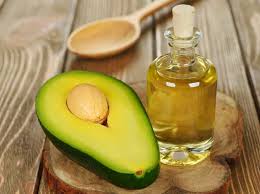Hair care is super essential, but occasionally it might sound like a loaded to-do list. If we dye our hair, we need special shampoos to last it; if we use a lot of dry shampoo, we need a scalp scrub to remove the build-up; and if we use hot equipment to tame and style our strands, we need a protector to help us prevent long-term harm. Ok, we’re coming with good news: it turns out that you may already have what you need to defend your strands sitting right under your nose (as in, inside your pantry).

Many of the oils we cook with can be used to shield our hair from the heat applied when styling. Although some oils are better used on some hair styles than others, using oils that you already have at home offers a more natural solution to your heat protectors and acts as a one-stop shop with plenty of additional benefits to provide you a well-rounded hair care routine. Experimenting with DIY Protectives should be an educated decision—if used wrongly, it may do some serious damage—which is why we have obtained guidance from a trichologue to help lead you through it. Read on to read about the many advantages of replacing your multitude of hair products with one of these DIY heat protection solution.
Safety Considerations While DIY Heat Protectants
The purpose of any heat Protectants is to minimise the amount of damage caused by applied heat. “When we use heat styling machines, they strip the hair of their natural oils and proteins by breaking down the hydrogen bonds,” Friese says. Heat Protectants are used to serve as a shield that covers the surface of the hair shaft to provide it an extra layer of protection, causing the heat to enter steadily instead of all at once.
Related Post: Silicone Free Shampoo? Yay Or Nay?
Friese adds, “Different hair types take different temperatures to achieve the perfect look.” Many oils-such as coconut oil or avocado oil, which you may already have in your pantry at home-can be used successfully in a DIY formula to protect the strands from added heat, but the greatest caution to take into account is the smoke of each oil. “Each oil has a different smoking point (the temperature at which the oil burns),” says Friese. If this smoke point is crossed and your DIY protective formula is used with a heat tool at too high a temperature, the oil will start to burn and you could end up with the opposite effect of getting severely burnt, fried hair as a result.
Much of the counter brands use silicones as a hair barrier since they are normally water soluble and, by serving as a sealant, they can hold excess frizz at bay. However, these kinds of added additives can block moisture from getting into the hair at all times and over time can make strands brittle and dry. Replacing your heat Protectants with one of the oils that you may find in your pantry will serve a better solution for your strands in the long term, since they really help to seal in moisture.
Chemicals that are sprayed at high temperatures should be avoided.
Toxic chemicals can be inhaled or ingested through your pores in most consumer heat protectant sprays (as well as shampoos, conditioners, and other makeup and beauty products). Here are a few popular ingredients to avoid if you want to stay safe.
1. Acrylates (acrylamides)
To alleviate static, acrylates, or copolymers, are used to produce a film over your hair. They’re also used to encourage “hold” in nail polish and other hair styling items. Unfortunately, they’ve been classified as potential carcinogens as well.
2. Quaternium-70 (Quaternium-70)
This class of chemicals, also known as “quats,” are positively charged particles that can bind to hair and provide a layer of protection. They could, however, be harmful to your health: the Environmental Working Group lists the common quat, quaternium-70, as a potential immunotoxin linked to developmental and reproductive issues.
Dimethicone is the third ingredient on the list.
Dimethicone is a silicone that is commonly used in cosmetics, such as heat protectant sprays. Silicones help to preserve the sheen of the hair while also shielding the colour of the hair from fire. Dimethicone, like quats, is classified as a hazardous substance on the Environment Canada Domestic Substance List, and the EWG recommends that it be avoided in cosmetics.
4. Polysiloxane Hydroxypropyl (Hydrolyzed Wheat Protein)
Wheat protein peptides are also commonly used in hair styling materials. Even though gluten reactions to these peptides are uncommon, it’s important to avoid them if you’re gluten-free or paleo. Even so, heavy metals like arsenic have been discovered in wheat protein hydrolyzed. Hydrolyzed wheat protein should be kept away from your nose, mouth, and any damaged skin, which can be difficult if you’re applying a heat protectant spray too close to where it might be inhaled unintentionally.
Also read: Serum VST
Ingredients that help to keep you cool in the summer
You don’t have to give up your heating equipment, thankfully. Natural, nourishing oils and essential oils can help minimise static and nourish strands while also acting as a light heat barrier. The ingredients in our homemade heat protectant spray—and why they work—are mentioned below.
In short, DIY heat Protectants can be a very reliable, holistic solution for your strands by solving several hair problems at once, but you need to use them cautiously and correctly depending on your hair type and the temperature needed for your ideal look. With that out of the way, keep reading the oils that Friese suggests using at home as a DIY heat protector.
Also read: Silk Pressing Hair – Everything You Should Know
1. Coconut Oil

Is it surprising to see coconut oil on this list? Coconut Oil is a commodity that keeps giving away. With a low smoke point of 350 degrees, this oil is the perfect choice for those with finer hair. That being said, all hot tools used to cover hair with a coconut oil base do not exceed 325 degrees of temperature.
Coconut oil is a conditioning and sealant property. It can repair existing damage in the hair because it actually penetrates through the hair shaft instead of just coating the shaft’s exterior, like many other protectants on the market tend to do. Not only does this oil smooth your hair down and keep you frizzy, but it can make your hair feel even smoother.
Also read: best anti aging eye cream
Directions
For good use as a heat protector, melt 1 teaspoon of coconut oil and dilute with 3/4 cup of water. Add the mixture to the spray bottle and shake just before each application. It’s always best to apply this solution to wet hair and hold it all in the middle of the shaft to the ends, away from the scalp. Spraying this protective on dry hair or applying it somewhere near the roots will make your hair look greasy, which you want to be particularly cautious of fine lines that can be quickly weighted down.
2. Avocado Oil

One of the specific benefits of using avocado oil as the basis for your DIY heat protector is that it protects your hair from all heat: heat from hot equipment, but also natural heat from being in the sun. Avocado oil is a perfect protective choice for dye treated hair or greying hair due to this perk alone. It also has an incredibly high 520-degree smoke point, making it a perfect pick for either hair density or texture.
Directions
To use avocado oil as the foundation of your DIY heat protector, mix 1 tablespoon of oil with at least 1 cup of water in a spray bottle and shake vigorously before each use. Let the hair dry a little bit, if necessary, just let the oil soak in before adding or exposing to some kind of heat.
Avocado Oil is very lightweight, but it’s not going to leave a bulky feeling on thinner threads. It is also high in vitamin E, which is packed with antioxidant properties that could lead to hair growth if it is also added to the scalp. Whatever kind of hair you have, add this protective oil when your hair is still damp and give it time to soak in.
3. Grapeseed Oil
If you have coarse hair and dry skin, grape seed oil is the right choice for you as its specific properties relieve the effects of dandruff and dermatitis. Grapeseed Oil also has a high smoke point of 420 degrees, making it a better substitute for darker, thicker hair textures. Keep the irons down to 400 degrees as a safety measure when using this oil to prevent it from touching anywhere above the smoke point when it starts to burn. Grapeseed oil naturally seals hair cuticles to keep in moisture and has conditioning properties that make the hair smooth and shiny. It’s also rich in vitamin E and antioxidants that make it excellent for scalp wellbeing as well.
Directions
If you want to use grapeseed oil as your DIY heat protection solution, you shouldn’t have to blend it with or dilute it in any way. Simply add 4-6 drops of oil to the palms of your hands, rub your hands together, and rake the oil over your hands from mid-shaft to the ends. This oil absorbs easily and can produce promising effects for dry, dead hair with regular usage.
